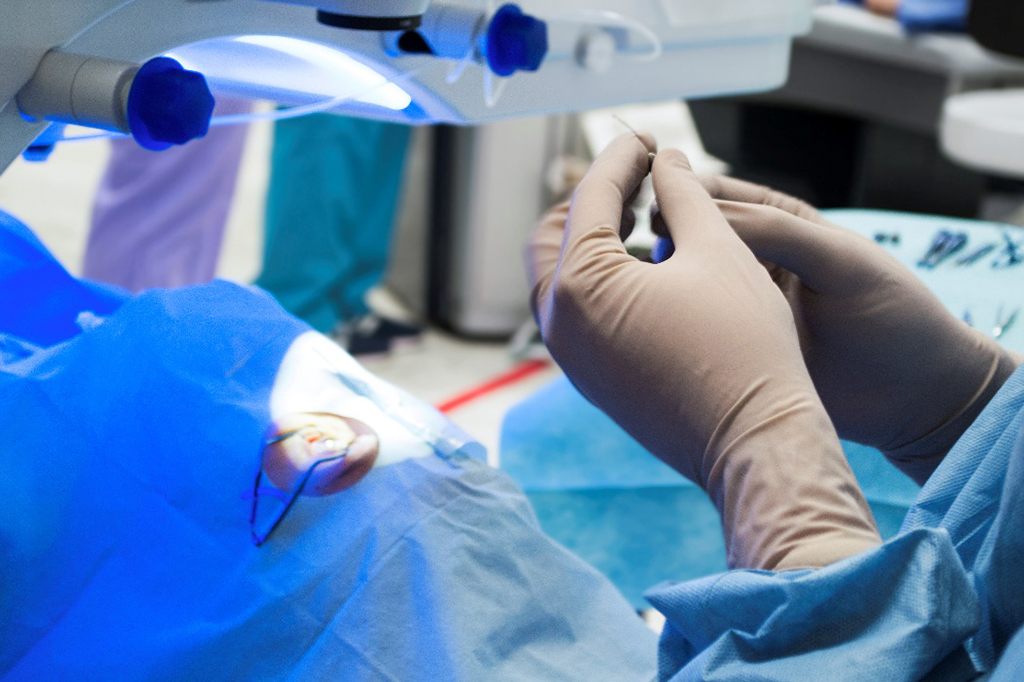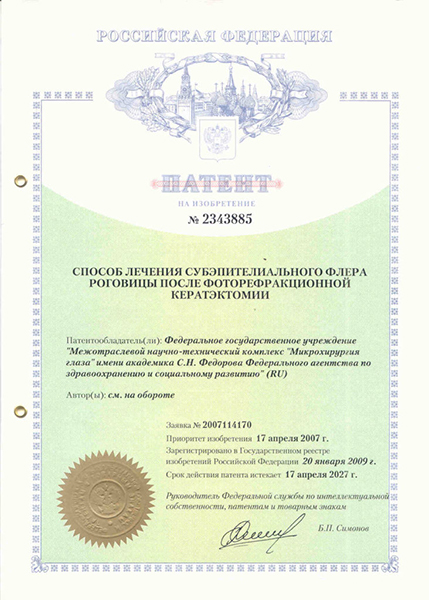Correction of vision
SMILE laser vision correction
SMILE vision correction technology. The principle of change of curvature of a cornea offered L.A. Ruiz by removal of a stromalny layer of a cornea (the automated keratomilez) have been embodied in femtosekundny FLEx technology on the VisuMax installation by the Carl Zeiss Meditec company (Germany).
The concept of the company consists in a full complex of surgical manipulations, such as cut and elimination of a stromalny layer of a cornea (lentikula) with the refraction purpose on only one FS to the laser machine, without use of the excimer laser.
The priority on development of this technology and its first clinical carrying out belongs to the doctor and scientific W. Secundo.
Formation of a corneal lentikula at implementation of the ReLex procedure requires pretsizionno exact focusing of a laser beam in Strom of a cornea and setup of the laser machine (energy of an impulse, distance between cavitational bubbles). Also it is necessary to pay tribute of the company to the producer which has brilliantly coped with an objective.

The technique of SMILE – “small incision lenticule extraction” became the following step of development of FLEx and ReLex technology.

Basis of a technique is optimization and reduction of intsizionny impact on cornea biomechanics as when holding a procedure there is almost intact Boumenova a membrane.
Unlike the operation FLEx after a “plane” femtodissektion and formation of an intrastromalny lentikula a femtodissektion of the corneal valve not to be made. The following stage carries out a femtodissektion of a corneal section of long 4-5 mm in the form of “smile” through which removal of a lentikula is made.
Optimum diameter of the formed lentikula according to authors of a technique is 6,0 mm, the published clinical results of operations are comparable to the results received about use of the excimer laser, but to the advantages described above.
Scheme of operation SMILE
Vision correction CLEAR
Corneal lenticule extraction for advanced refractive correction (CLEAR) is a newly developed application from Ziemer for the treatment of myopia and astigmatism. This video explains the guided extraction, the centration options as well as the low energy concept of this new application “CLEAR”
Laser vision correction Femto Lasik
Vision correction with Femto-Lasik. After carrying out the initial stages of any ophthalmologic operation (preoperative processing of the operational field disinfecting solution, instillations of anesthetic of 0,4% of an inokain) and installations of the blepharostat to be made installation of a vacuum ring in the opened state. From that, how correctly it is established, the quality and correctness of a cut will depend in many respects.
- The first stage – the focused laser beam on a certain thickness of a stroma of a cornea makes a fabric femtodissektion in the horizontal plane, forming valve “bed”. Then in the vertical plane from valve “bed” to a surface of an epithelium to be made the regional cut – forming edge of the corneal valve ( “side cut”).
- The second stage – raising of the created flap.
- The third stage – carrying out an eksimerlazerny ablyation of a stroma of a cornea
- The fourth stage — laying of the corneal flap.
Carrying out and laying of the valve are carried out as standard and presented in the video:
Photorefraction keratectomy (PRK)
The cornea of an eye has layered structure: epithelium, boumenova cover, Stroma, destsemetov membrane, back epithelium. The steady refraction effect is reached only at change of geometry of a stroma (the main layer of a cornea). Achievement of a stroma is a serious problem therefore all versions PRK, aiming at an ablyation of layers of a stroma (actually refraction stage of operation), differ with the way “passings” of the two first layers: epithelium and boumenovy cover. Standard “classical” PRK as the first stage of operation assumes just mechanical removal (skarifikation) of an epithelium and boumenovy membrane. There are options of a combination of chemical and mechanical removal of an epithelium called by LASEK, Epi-LASEK. At the same time time spent for this procedure occupies more than a half of all time of operation.
Now when carrying out PRK gradually gains popularity a preoperative deepitelization the same excimer laser which carries out a refraction stage. Though it, according to doctors, gives a significant prize in a postoperative condition of a cornea of an eye, the general name of a technique isn’t developed yet. In Russia the term “transepitelialny” is most often used. It is carried out by the scanning laser beam.
The patent on treatment and Haze prevention after PRK is offered

Disadvantages:
— The expressed postoperative discomfort until a full epitelization of a zone of operation: 3 — 4 days.
— Long (up to 1 month) restoration of visual functions in full.
— Significant probability of postoperative turbidity of a cornea – subepithelial haze.
Implantable Contact Lens (ICL)
An excellent Vision Correction Option The ICL (Implantable Contact Lens) is a state-of-the-art refractive error solution that is ideal for anyone who has the need or desire for removal of power with high quality of vision correction. ICL or Implantable Contact Lens, as the name suggests, is a kind of lens which is implanted into the eye and does not require frequent removal like a normal contact lens. This phakic intraocular lens has numerous advantages including its correction of the widest range of myopia (near sightedness), hyperopia (far sightedness) and astigmatism (cylindrical power).
Implantable contact lens can correct a wide range of vision errors by permanently inserting a Contact lens in front of the natural lens of the eye. ICL is a kind of soft contact lens which is inserted into the eye through a very small incision Just like LASIK or Wavefront Lasik it takes only 5-10 minutes for the procedure
The lens is customized according to each eye’s shape and size Widest power correction range from +10D to -20D with cylinder upto 6D Made from a material called “Collamer” which is bio compatible (safe to stay in the eye for very long time) This new technique is similar to cataract surgery, but the natural lens remains in place so the eye’s natural focusing ability is preserved. An implantable contact lens is beneficial because it becomes a permanent fixture of the eye, avoiding time consuming maintenance. It does not get lost, or have to be replaced like glasses and contact lenses. Implantable contact lens procedures are being used on highly nearsighted and farsighted patients who may not be candidates for the more common laser procedures such as LASIK, LASEK, and PRK. Unlike laser vision correction procedures that permanently change your vision, it is possible to later remove an ICL.
Because the implantable contact lens is also ideal for patients with contraindications for laser refractive surgery, some people may consider the ICL as an alternative to LASIK; however, as you can see, it is so much more than that. It is often compared to the corneal refractive procedure because the ICL takes refractive surgery beyond the limits of LASIK. Patients, who may not discover the ICL until they begin to search for an alternative treatment to avoid LASIK or PRK, realize that the ICL is not just an alternative; it is the good choice for superior vision quality.
Advantages of Implantable contact lens
— Preserves accommodation
— No corneal tissue removed
— Retains corneal asphericity
— Possibly retains contrast sensitivity
— Removable






